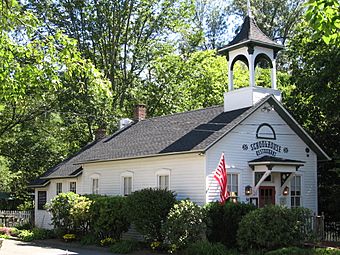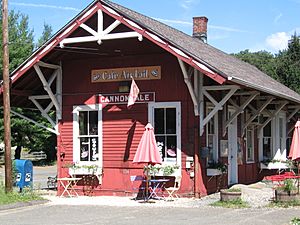Cannondale Historic District facts for kids
Quick facts for kids |
|
|
Cannondale Historic District
|
|

1872 Cannondale School building, housing a restaurant
|
|
| Location | Roughly bounded by Cannon, Danbury and Seeley Rds., Wilton, Connecticut |
|---|---|
| Area | 202 acres (82 ha) |
| Architectural style | Greek Revival, Late Victorian, Colonial |
| NRHP reference No. | 92001531 |
| Added to NRHP | November 12, 1992 |
The Cannondale Historic District is a special area in the town of Wilton, Connecticut. It's like a living museum! This district protects many old buildings and places that show what life was like in the past. It covers about 202 acres and includes 58 important buildings.
These buildings are mostly found along Danbury Road (which is also U.S. Route 7) and near the Cannondale train station. A few more are on Seeley Road. The district is important because it shows how a small town grew. It was once a mix of farms and a busy center for businesses.
You can see many different kinds of old buildings here. They show styles like Greek Revival, Victorian, and Colonial Revival. These buildings tell the story of how people lived, worked, and traveled from the early 1800s to the early 1900s.
Contents
What Makes Cannondale Special?
The Cannondale Historic District is unique because it shows many different parts of daily life from long ago. You can find buildings that were once farms, homes, churches, and schools. There were also places for community groups, small factories, and even the first post office!
All these different uses were very close together. This shows how people lived before big stores and modern transportation. It helps us imagine what life was like for people who lived here many years ago. The district is also famous for its beautiful old buildings and its rich history.
Cannon Crossing: A Unique Shopping Area
A fun part of the historic district is "Cannon Crossing." This area has many old buildings from the 1800s that have been carefully fixed up. They are now used as shops and restaurants! Cannon Crossing is on Cannon Road, right across the railroad tracks from the Cannondale train station.
This special development was started by an actress named June Havoc. She owned the property for a while before selling it in 1989. One of the most interesting buildings here is the 1872 Cannondale School. June Havoc actually had this school building moved to its current spot in the late 1970s!
Historic Buildings to Explore
Many buildings in the Cannondale Historic District are very old and have interesting stories. Here are some of the most notable ones:
On Cannon Road
- Nelson S. Hurlbutt House (1922) - This house at 8 Cannon Road has a special roof shape called a gambrel roof. It also has a porch with round columns.
- Godfrey Academy (1849) - Located at 20 Cannon Road, this building was moved here in 1961 from another street.
- Cannondale Station (1892) - The train station at 22 Cannon Road is a one-story building with a wide roof. It has fancy decorations and a unique peak ornament.
- Charles Gregory Store and Post Office (around 1850) - This building at 24 Cannon Road was once a store and the first post office in Cannondale. It has two and a half stories and a gable roof.
- Behind the store, there's a small, two-story house built around 1900.
- Cannon Grange Hall (1899) - At 25 Cannon Road, this building was used by a community group called the Grange. It has decorative shingles and stickwork.
- Charles Gregory Dam (around 1910) - You can find this dam at 30 Cannon Road. It has stone walls and a special wheel-pit that once powered a gristmill.
- Gregory Gristmill Tenant House (around 1900) - This two-story house at 32 Cannon Road was likely where someone who worked at the gristmill lived.
- B. F. Brown Boarding School (1857) - This three-story building at 33 Cannon Road has a Greek Revival style entry. It was once a boarding school.
- There's also an old barn behind the school.
- Cannondale School (1872) - This one-story school building at 34 Cannon Road is very charming. It has a special cupola (a small dome) on its roof. Like Godfrey Academy, this building was also moved to its current spot in 1979.
- Lockwood Academy (1851) - Also known as 42 or 43 Cannon Road, this building has a simple style with some Greek Revival touches.
- A barn is located behind the Lockwood Academy.
- Jesse Gregory House (around 1800) - This very old house at 109 Cannon Road has been changed over the years. It shows a mix of Federal and Colonial Revival styles.
On Danbury Road
- David Henry Miller III House (1907) - This large house at 426 Danbury Road has a porch that wraps around it. It also has a special covered entrance for cars called a porte-cochere.
- A barn is located behind this house.
- Hiram and Mary Cannon Jones House (around 1835) - At 436 Danbury Road, this house is in the Greek Revival style. It has a grand porch with Ionic columns.
- This property also has a barn.
- Samuel Marvin House (around 1810) - This house at 444 Danbury Road is in the Federal style. It has unique oval windows in its gables.
- A barn is also on this property.
- Zion Hill Methodist Episcopal Church (1844) - This church at 470 Danbury Road is a tall, single-story building with a grand entrance and a belfry (bell tower).
- Zion Hill Cemetery (around 1840) - Next to the church, this old cemetery has rows of gravestones from the mid-1800s.
- Lewis Hurlbutt House (1909) - This Colonial Revival house at 475 Danbury Road has a porch that wraps around it and a special "Palladian window" in its front gable.
- A carriage barn behind this house is also historic.
- Noah Partrick House (1837) - This house at 481 Danbury Road has two and a half stories and a simple, classic look.
- Charles Scribner House (around 1830) - This house is a mix of Greek Revival and Colonial Revival styles, with a porch added around 1910.
- William Nichols House (around 1800/1840) - At 493 Danbury Road, this house was originally a center-chimney home. It was updated around 1840 with Greek Revival features.
- The barn on this property is also historic.
- Thaddeus Quick House (around 1845) - This Greek Revival house at 496 Danbury Road has some later Victorian additions like bay windows.
- The barn north of this house is also historic.
- Azor Belden House (around 1788) - This is one of the oldest buildings, at 539 Danbury Road. It was greatly expanded and changed over time.
On Olmstead Hill Road
- Gersham and Mary Ann Partrick House (around 1875) - This two-story house has a simple Victorian style with a full porch.
- The barn on this property is also considered historic.
On Seeley Road
- Polly and William Wakeman House (around 1840/1907+) - At 36 Seeley Road, this house started as a Federal-style home. Many wings were added between 1907 and 1940.
- The barn on this property is also historic.
- Hannah Lounsbury House (around 1852) - This house at 45 Seeley Road was originally a plain, three-bay house. It was updated after 1950 with a new wing and Colonial Revival entry.
- The barn on this property is also historic.
- Hickock House (around 1810/1915+) - At 105 Seeley Road, this old house was originally a five-bay home with a central chimney. Wings were added in the 20th century.
- The barn on this property is also historic.
Images for kids





